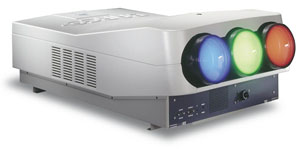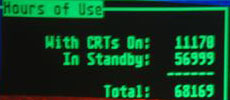 |
CRT Primer
|
Updated: April 2006 |
Why CRT Projectors?
CRT projectors have been around since
the dawn of television. An early
electronics magazine that I have from
the 1950’s shows a large B/W video
projector capable of projecting a 20’
wide image onto a wall. I have seen and
operated an ancient tube chassis 3-gun
1000-lumen projector from the 1960’s
that was used for the first Wrestlemania
in 1986. Not a great picture, but at the
time, an entire arena full of people
paid $20.00 each to see Hulk Hogan duke
it out on that projector.
 Barco 808s
Those of you that have seen a CRT
projector in person will agree on one
thing: they are large and heavy beasts.
The lightest CRT projector weighs about
50 lbs and the heaviest that I have seen
is about 250 lbs. There’s no getting
away from the weight due to the glass
picture tubes and the three lenses that
these units require. Typical dimensions
are about 24”x18”x12” for a small
projector, and a larger unit can be
40”x32”x16”.
Thanks to misinformed (and high
commission) LCD and DLP sales people,
many myths surround the ‘mystique’ of
the CRT projector. These include:
- expensive and short tube life
- CRT’s need constant adjustment
- CRT’s never give a good picture
- you need to call in a tech every time
you need to adjust it.
As of this
writing (October 2007), CRT projectors still give the best quality image for a
home theatre. The overall sharpness, focus, lifelike fleshtones and three
dimensionality of the image still cannot be duplicated by any other type of
video projector. With the recent release of HDMI and
DVI modules, all data grade CRT projectors can now be connected to any
current digital device, including Blu-ray and HD-DVD players. CRT obsolete? I
think NOT! Yes, there is a time and place for all types of
projectors. While I don’t sell a lot of digital sets in any given year (3-4
maybe), the wholesalers that recommend sets to me seem to flip-flop on whether
it’s DLP or LCD that I should be installing. In 2003, I was unanimously told to
sell DLP only for home theater use. In late 2004, the same suppliers were back
to recommending LCD, claiming that the DLP’s were less reliable than LCD units.
If you are looking for a small portable and easy to set up projector for
computer use, LCD or DLP are the way to go. There are literally thousands of
models out there that are available on
eBay or elsewhere. Keep in mind that the
life span of any particular model seems to be about 6 months as the DLP and LCD
race for technology improvements continues, so any model is replaced after about
6 months. There are numerous companies that have gone out of business making
parts hard to get for certain models and makes, plus many bulbs are obsolete and
are simply not available. Currently many manufacturers are offering 2000, 4000
and even 6000 hour bulbs to compete with the typical 10,000 hour life of a CRT
tube. The problem is, many of these bulbs lose their brightness over time, and
so the white areas of an image of an LCD or DLP projector may turn yellowish or
other colors due to a lower light output of an aging bulb. I’ve been told by
manufacturers’ reps that typically the light output of a bulb goes down by 20%
at the half life point. This also means that the light output is no longer pure
white, so your whites (hockey ice!) turns yellow and the color spectrum changes
significantly before the bulb dies. Depending on how picky you are depends on
when you change the bulb. or elsewhere. Keep in mind that the
life span of any particular model seems to be about 6 months as the DLP and LCD
race for technology improvements continues, so any model is replaced after about
6 months. There are numerous companies that have gone out of business making
parts hard to get for certain models and makes, plus many bulbs are obsolete and
are simply not available. Currently many manufacturers are offering 2000, 4000
and even 6000 hour bulbs to compete with the typical 10,000 hour life of a CRT
tube. The problem is, many of these bulbs lose their brightness over time, and
so the white areas of an image of an LCD or DLP projector may turn yellowish or
other colors due to a lower light output of an aging bulb. I’ve been told by
manufacturers’ reps that typically the light output of a bulb goes down by 20%
at the half life point. This also means that the light output is no longer pure
white, so your whites (hockey ice!) turns yellow and the color spectrum changes
significantly before the bulb dies. Depending on how picky you are depends on
when you change the bulb.
As of the update to this document, I have seen a number of LCD
and DLP projectors come through my shop for repair. As stated above, these small
< 10 lb projectors run very hot as the bulb is in very close proximity to the
main circuit boards. While some of these projectors have come out of sports bars
that do not clean the air filters and thus the internal temperature increases
significantly and shortens bulb and set life, the fact remains that these small
projectors simply cannot be serviced the way CRT projectors can. Digital
projector circuit boards are treated the way a sound or video card is dealt with
in your computer: Do not repair the board, throw it away and install another
one. The problem is, unlike a $50.00 sound card for your computer, a video
processing board can run almost as much as a replacement projector.
 Marquee 8500 CRT projector, Jan 1996 build. 11,000 hours on the tubes, 68,000 on the chassis. Used in a 3D virtual reality system run 24 hours/day for nearly 8 years without turning it off. Amazing!
I’ve seen time and time again where I’ve checked into the availability of a
replacement bulb for a > 5 year old digital projector, only to be told that they
are no longer available. Therefore, if you’re shopping for a used digital
projector, buy a spare bulb for it now while it is available, and keep the air
filters in the unit clean.
The bottom line on digital projector bulb life is that it appears that the
life span advertised by manufacturers is based on a 10-12 hour cycle. Thus, to
get the rated 2000 hours of bulb life, the projector needs to be on for 10-12
hours, turned off for a while, then run again for 10-12 hours. The problem is,
this is not commonly how a digital projector is used in the home. If you turn a
digital projector on and off three times a day, there’s a really good chance
you’ll get significantly less life out of a bulb than advertised. The turn on
pulses that the bulb is subjected to is very hard on the bulb.
While only a handful of CRT models are still being manufactured as of 2003,
there are so many available parts, modules and used projectors that parts
availability (with a few exceptions) is not a problem for even 15 year old
models.
If you don’t mind the large case that houses a CRT video projector, some
occasional ‘tweaking;’ and the best picture for a home theatre, then keep
reading, as CRT is for you!
|
|



